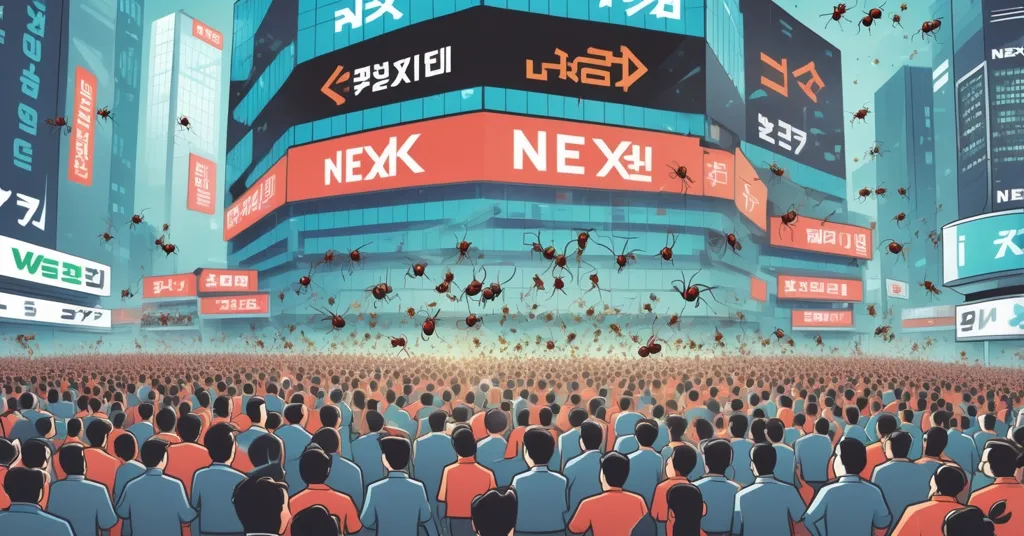Nextrade Captures 30% of South Korea’s $2.4T Stock Market, Challenges KRX Dominance

Nextrade Shakes Up South Korea’s $2.4 Trillion Stock Market with a 30% Slice
South Korea’s financial landscape is undergoing a radical transformation as Nextrade, a brash new stock exchange launched in March, has surged to capture nearly 30% of the nation’s massive $2.4 trillion equity market. From a humble start at under 4% market share, this upstart is challenging the 70-year dominance of the Korea Exchange (KRX), drawing in swarms of retail traders and catching the eye of global investors while wrestling with regulatory pushback.
- Rapid Rise: Nextrade jumped from under 4% to nearly 30% of South Korea’s equity trading value in months.
- Retail Dominance: 86% of users are retail traders, fueled by longer hours and fees 20–40% cheaper than KRX.
- Regulatory Tensions: Trading caps have led to suspensions of 150 stocks, despite temporary relief on some limits.
Nextrade’s Meteoric Ascent
For decades, the Korea Exchange has been the unassailable giant of South Korean trading, operating a rigid 6.5-hour window from 9 a.m. to 3:30 p.m. Nextrade flipped the script with a 12-hour daily schedule stretching from early morning to 8 p.m., giving everyday traders the flexibility to play the market outside traditional hours. Couple that with transaction fees slashed by 20–40% compared to KRX, and it’s no shock that retail traders—locally nicknamed “ants” for their small but collectively powerful trades—make up 86% of Nextrade’s user base. These ants are buzzing, especially during pre-market sessions (trading windows before the official market opens), diving into assets ranging from cryptocurrency to the Magnificent Seven stocks—think U.S. tech titans like Apple and Nvidia—and even high-risk leveraged U.S. ETFs, which use borrowed funds to amplify potential gains or losses.
For those new to the scene, Nextrade operates as an alternative trading system (ATS), a platform that sidesteps the rigid structure of traditional exchanges like KRX, offering more flexible pricing and rules. Spearheaded by Kim Haksoo, a former financial regulator, Nextrade’s legal roots trace back to 2013, with preliminary approval granted in 2023. Its growth isn’t just a domestic quirk; it’s a global standout, as detailed in reports about Nextrade’s dominance in South Korea’s stock market. Kang Sohyun, Senior Research Fellow at the Korea Capital Market Institute, summed it up sharply:
“It’s unprecedented globally. If you look at other similar markets with one large exchange and smaller bourses, such as Australia and Japan, Nextrade’s expansion has been very rapid.”
Stack Nextrade against international peers, and its 30% market share looks downright audacious. In the U.S., over 80 ATS platforms collectively handle about 20% of trading value, while in Japan, three ATS players split a mere 10%. Stocks like Doosan Enerbility are now seeing more action on Nextrade than on KRX, a clear sign this newcomer has an iron grip on the market.
Retail Traders Fuel the Fire
South Korea’s retail trading culture is legendary, often driving wild market swings—think back to the 2021 meme stock frenzy when local “ants” pumped obscure stocks to absurd heights. Nextrade has tapped into this fervor with a vengeance, empowering the average Joe with a taste of financial sovereignty through low costs and extended access. Many of these traders aren’t just sticking to traditional equities; they’re dabbling in crypto markets, reflecting South Korea’s status as a global leader in per-capita cryptocurrency adoption. This blending of decentralized finance (DeFi)—financial systems built on blockchain tech that bypass banks and brokers—with legacy markets is a fascinating trend. Whether traders are swapping Bitcoin, altcoins, or stablecoins alongside stocks on Nextrade isn’t fully clear, but the speculative spirit mirrors the early days of Bitcoin’s promise: power to the people.
Foreign investors are starting to take notice as well, with participation climbing from near zero at launch to 11% now. This uptick signals growing global confidence in Nextrade’s model, though it also raises questions about potential capital flight if volatility spikes. Domestic institutions, meanwhile, are playing it safe, citing “system stability worries.” It’s a classic divide: the little guy embraces disruption, while the big players cling to the old guard.
Regulatory Roadblocks: Innovation vs. Stability
Here’s where the fairy tale gets gritty. South Korea’s Financial Services Commission (FSC) isn’t exactly rolling out the red carpet for Nextrade. A 15% cap on overall market volume has led to the suspension of nearly 150 stocks in August and September, a blunt reminder that innovation doesn’t come without oversight. A separate 30% cap on single-stock trading volume was temporarily lifted for 500 stocks in September, with the FSC justifying the move:
“It would become impossible for investors to trade during their commute to office [without lifting the single-stock volume cap].”
Yet, these restrictions underscore a deeper tension. Regulators are playing babysitter to a financial revolution, and it’s hard not to wonder if they’re stifling something transformative. On the flip side, their caution isn’t baseless—South Korea has seen speculative bubbles burst before, from crypto crashes to over-leveraged stock plays. Nextrade’s low barriers to entry might empower traders, but they also risk encouraging reckless bets. These ants are mighty, but are they marching toward a jackpot or a cliff?
Crypto Meets Stocks: A DeFi-Adjacent Experiment?
Nextrade’s appeal isn’t just about cheaper stocks; it’s a window into how traditional finance and decentralized systems might collide. With retail traders on the platform diving into cryptocurrency alongside equities, we’re seeing a hybrid financial culture emerge in South Korea. This isn’t Bitcoin’s pure vision of cutting out middlemen entirely—let’s be real, Nextrade is still a centralized platform—but it echoes the ethos of empowerment and access we champion. Could this model inspire truly blockchain-driven stock exchanges down the line, where trades settle on a decentralized ledger instead of a corporate server? Or are we just witnessing another speculative fever dream, pumped by hype and vulnerable to the same rug pulls we’ve seen in DeFi disasters like Terra/Luna?
We’re all for disruption at Let’s Talk, Bitcoin, but let’s not pretend leveraged ETFs or crypto gambles on Nextrade are golden tickets. Do your own research, folks—scammers and market manipulators thrive in environments dripping with hype. South Korea’s history of crypto volatility, with massive booms and busts over the past decade, serves as a stark warning that innovation without guardrails can burn fast and hard.
Legacy Under Siege: What’s KRX’s Move?
While Nextrade steals the spotlight, the Korea Exchange isn’t exactly sitting pretty. Losing nearly a third of market share in under a year is a brutal wake-up call for a 70-year incumbent. So far, there’s little public word on whether KRX plans to fight back with fee cuts, extended hours, or other perks to lure traders. Are they banking on regulatory protection to keep Nextrade in check, or are they too slow to adapt to a retail-driven, tech-savvy market? This battle between a legacy giant and a nimble disruptor feels like a microcosm of the broader financial shift we’re witnessing—centralized titans versus decentralized upstarts, even if Nextrade itself isn’t fully on-chain.
What’s Next for South Korea’s Market Disruption?
Zooming out, Nextrade’s story fits into South Korea’s larger push to modernize its capital markets while navigating global economic currents. High-level tariff talks with the U.S., tied to a $350 billion investment fund, and meetings between Korean business tycoons and figures like Donald Trump at Mar-a-Lago signal an aggressive drive for international relevance. How this plays into domestic tolerance for platforms like Nextrade remains unclear—will regulators loosen the leash to boost innovation, or clamp down harder to protect stability amid geopolitical stakes?
Nextrade stands as a beacon of what’s possible when hungry markets meet bold ideas, especially in a crypto-crazed nation like South Korea. Yet, the balance between freedom and oversight will define whether this is a lasting game-changer or a cautionary tale. Could its model of empowering the little guy be a blueprint for blockchain-driven financial systems, or just another bubble waiting to pop? One thing is certain: the ants are marching, and the old guard better watch out.
Key Questions on Nextrade and the Future of Finance
- What’s driving Nextrade’s explosive growth in South Korea?
Longer trading hours of 12 hours daily and fees 20–40% cheaper than the Korea Exchange have attracted retail traders, who dominate 86% of activity, pushing Nextrade to a 30% market share since March. - How are regulators balancing innovation and risk with Nextrade?
The Financial Services Commission maintains a 15% market volume cap, suspending nearly 150 stocks, while temporarily easing a 30% single-stock cap for 500 stocks to meet trader demand, highlighting the push-pull of progress versus stability. - What’s the link between Nextrade and cryptocurrency trends?
Retail traders on the platform are investing in crypto alongside stocks, mirroring South Korea’s high digital asset adoption and blending traditional markets with decentralized finance principles. - How does Nextrade compare to global trading disruptors?
Its 30% market share outshines the U.S. ATS landscape at 20% across numerous platforms and Japan’s 10% among three players, marking it as a uniquely rapid force in financial disruption. - Can Nextrade’s rise influence decentralized finance adoption?
By prioritizing access and affordability, Nextrade echoes decentralization’s core values, potentially paving the way for blockchain-based trading systems, though speculative risks remain a glaring concern.



